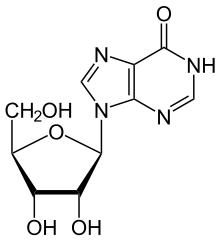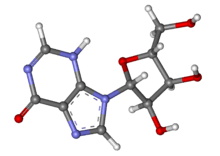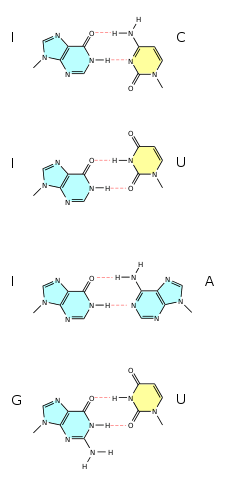Inosine
Inosine is a nucleoside that is formed when hypoxanthine is attached to a ribose ring (also known as a ribofuranose) via a β-N9-glycosidic bond.
 | |
 | |
| Clinical data | |
|---|---|
| AHFS/Drugs.com | International Drug Names |
| ATC code | |
| Legal status | |
| Legal status |
|
| Pharmacokinetic data | |
| Metabolism | Hepatic |
| Identifiers | |
IUPAC name
| |
| CAS Number | |
| PubChem CID | |
| IUPHAR/BPS | |
| DrugBank | |
| ChemSpider | |
| UNII | |
| KEGG | |
| ChEBI | |
| ChEMBL | |
| CompTox Dashboard (EPA) | |
| ECHA InfoCard | 100.000.355 |
| Chemical and physical data | |
| Formula | C10H12N4O5 |
| Molar mass | 268.23 g/mol g·mol−1 |
| 3D model (JSmol) | |
SMILES
| |
InChI
| |
| | |
Inosine is commonly found in tRNAs and is essential for proper translation of the genetic code in wobble base pairs.

Knowledge of inosine metabolism has led to advances in immunotherapy in recent decades. Inosine monophosphate is oxidised by the enzyme inosine monophosphate dehydrogenase, yielding xanthosine monophosphate, a key precursor in purine metabolism. Mycophenolate mofetil is an anti-metabolite, anti-proliferative drug that acts as an inhibitor of inosine monophosphate dehydrogenase. It is used in the treatment of a variety of autoimmune diseases including granulomatosis with polyangiitis because the uptake of purine by actively dividing B cells can exceed 8 times that of normal body cells, and, therefore, this set of white cells (which cannot operate purine salvage pathways) is selectively targeted by the purine deficiency resulting from inosine monophosphate dehydrogenase (IMD) inhibition.
Reactions
Adenine is converted to adenosine or inosine monophosphate (IMP), either of which, in turn, is converted into inosine (I), which pairs with adenine (A), cytosine (C), and uracil (U).
Purine nucleoside phosphorylase intraconverts inosine and hypoxanthine.
Inosine is also an intermediate in a chain of purine nucleotides reactions required for muscle movements.
Clinical significance
In the 1970s, inosine was used by athletes in Eastern countries in an attempt to improve performance. Subsequent studies in humans suggest that inosine supplementation has no effect on athletic performance.[1] Animal studies have suggested that inosine has neuroprotective properties. It has been proposed for spinal cord injury[2] and for administration after stroke, because observation suggests that inosine induces axonal rewiring.[3]
After ingestion, inosine is metabolized into uric acid, which has been suggested to be a natural antioxidant and peroxynitrite scavenger with potential benefits to patients with multiple sclerosis (MS).[4] Peroxynitrite has been correlated with axon degeneration [5]. In 2003, a study was initiated at the University of Pennsylvania MS Center to determine whether raising the levels of uric acid by the administration of inosine would slow the progression of MS.[6] The study was completed in 2006 but the results were not reported to NIH. A subsequent publication hinted at potential benefits but the sample size (16 patients) was too small for a definitive conclusion.[7] In addition, the side effect of the treatment was the development of kidney stones in four of 16 patients. Thus, additional studies are necessary to prove the treatment's efficacy.
With phase II trials for Parkinson's disease completed, inosine will continue to phase III trials. Earlier trials suggested that patients with the highest serum urate levels had slower progression of Parkinson's symptoms. The trial uses inosine to raise urate levels in those with levels lower than the population mean (6 mg/dL).[8][9][10]
Alseres Pharmaceuticals (named Boston Life Sciences when patent was granted) patented the use of inosine to treat stroke[11] and was investigating the drug in the MS setting.[12]
In the Anatomical Therapeutic Chemical Classification System, it is classified as an antiviral.[13]
Binding
Inosine is a natural ligand for the benzodiazepine binding site on the GABA A receptor.[14]
Biotechnology
When designing primers for polymerase chain reaction, inosine is useful in that it can pair with any natural base.[15] This allows for design of primers that span a single-nucleotide polymorphism, without the polymorphism disrupting the primer's annealing efficiency.
However, inosine pairs preferentially with cytidine (C) and its introduction to RNA, e.g. by the action of ADARs, thereby destabilizes double-stranded RNA by changing AU base-pairs to IU mismatches.[16]
Fitness
Despite lack of clinical evidence that it improves muscle development, inosine remains an ingredient in some fitness supplements.
Feeding Stimulant
Inosine has also been found to be an important feed stimulant by itself or in combination with certain amino acids in some species of farmed fish. For example, inosine and inosine-5-monophosphate have been reported as specific feeding stimulants for turbot fry, (Scophthalmus maximus) [17] and Japanese amberjack, (Seriola quinqueradiata).[18] The main problem of using inosine and/or inosine-5-monophosphate as feeding attractants is their high cost. However, their use may be economically justified within larval feeds for marine fish larvae during the early weaning period, since the total quantity of feed consumed is relatively small.
See also
- Inosine monophosphate dehydrogenase
- Inosine pranobex
- Nucleobase
References
- Kerksick, CM; Wilborn, CD; Roberts, MD; Smith-Ryan, A; Kleiner, SM; Jäger, R; Collins, R; Cooke, M; Davis, JN; Galvan, E; Greenwood, M; Lowery, LM; Wildman, R; Antonio, J; Kreider, RB (1 August 2018). "ISSN Exercise & Sports Nutrition Review Update: Research & Recommendations". Journal of the International Society of Sports Nutrition. 15 (1): 38. doi:10.1186/s12970-018-0242-y. PMC 6090881. PMID 30068354.
- Liu F, You SW, Yao LP, et al. (2006). "Secondary degeneration reduced by inosine after spinal cord injury in rats". Spinal Cord. 44 (7): 421–6. doi:10.1038/sj.sc.3101878. PMID 16317421.
- Chen P, Goldberg DE, Kolb B, Lanser M, Benowitz LI (2002). "Inosine induces axonal rewiring and improves behavioral outcome after stroke". Proc. Natl. Acad. Sci. U.S.A. 99 (13): 9031–6. doi:10.1073/pnas.132076299. PMC 124418. PMID 12084941.
- "Uric Acid In Multiple Sclerosis". WebCite. 2018. Archived from the original on 2009-10-27.
- "fedem.org".
- "Treatment of Multiple Sclerosis Using Over the Counter Inosine".
- Markowitz CE; Spitsin S; Zimmerman V; Jacobs D; Udupa JK; Hooper DC; Koprowski H (2009). "The Treatment of Multiple Sclerosis with Inosine". J Altern Complement Med. 15 (6): 619–625. doi:10.1089/acm.2008.0513. PMC 3189001. PMID 19425822.
- "Safety of Urate Elevation in Parkinson's Disease". Fox Trial Finder. 2018.
- "Safety of Urate Elevation in Parkinson's Disease". ClinicalTrials.gov.
- "Inosine Trial Secures Phase III Funding to Study Effect on Slowing Parkinson's".
- "bostonlifesciences.com".
- Kai-Jye Lou (2009). "The inosine conundrum (Alseres Pharmaceuticals Inc.)" (PDF). Nature SciBX.
- "ATC/DDD Index". World Health Organization Collaborating Centre. Retrieved Dec 20, 2017.
- Yarom, M.; Tang, X. W.; Wu, E.; Carlson, R. G.; Vander Velde, D.; Lee, X.; Wu, J. (July 1998). "Identification of inosine as an endogenous modulator for the benzodiazepine binding site of the GABAA receptors". Journal of Biomedical Science. 5 (4): 274–280. doi:10.1007/bf02255859. ISSN 1021-7770. PMID 9691220.
- Ben-Dov E (2006). "Advantage of Using Inosine at the 3′ Termini of 16S rRNA Gene Universal Primers for the Study of Microbial Diversity". Applied and Environmental Microbiology. 72 (11): 6902–6906. doi:10.1128/AEM.00849-06. PMC 1636166. PMID 16950904.
- (Bass and Weintraub, Cell, 1988).
- Mackie, A.M. (1987). Identification of the gustatory feeding stimulants. In: Chemoreception in Fishes. (ed. T.J. Hara). Elsevier Scientific Publishing Co., Amsterdam, pp. 275-291.
- Takeda, M. Takii, K. & Matsui, K. (1984). Identification of feeding stimulants for juvenile eel. Bull. Jap. Soc. Scient. Fish., 50: 645-651.